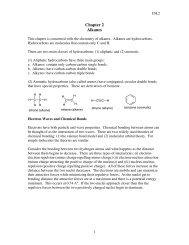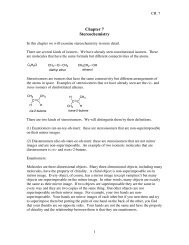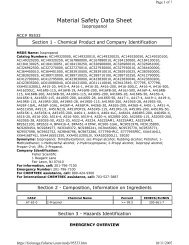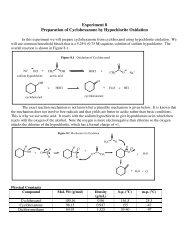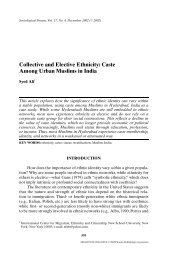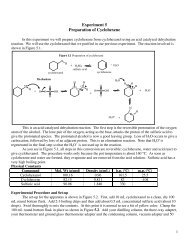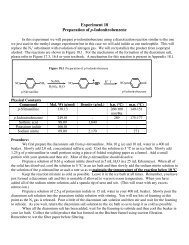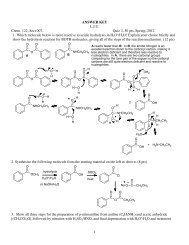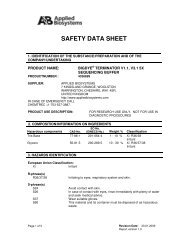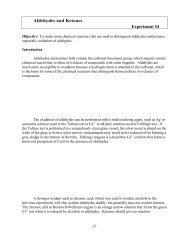Experiment 13 Qualitative Tests for Carbonyls; Unknown ... - myweb
Experiment 13 Qualitative Tests for Carbonyls; Unknown ... - myweb
Experiment 13 Qualitative Tests for Carbonyls; Unknown ... - myweb
Create successful ePaper yourself
Turn your PDF publications into a flip-book with our unique Google optimized e-Paper software.
Figure <strong>13</strong>.3 Copper (II) Oxidation of Aldehydes to Carboxylic AcidsORC HaldehydeO OH OO+ Cu 2+ - O C CH 2 C CH 2 C ONa sodium carbonate, H 2 OO CR C O - Na +O - carboxylic acid(sodium salt)blue copper-citrate complex+Cu 2Ored solidTest 4: Chromic Acid Test (also called Bordwell-Wellman Test)This test is similar to the Tollen’s test and the Benedict’s test in that it distinguishes aldehydes fromketones on the basis of their ease of oxidation. In the chromic acid test we use chromic acid to oxidizealdehydes to carboxylic acids; ketones do not react with chromic acid. Chromic acid is prepared by mixingchromium trioxide with dilute sulfuric acid. The orange Cr 6+ cation is reduced to the blue-green Cr 3+ ion.Figure <strong>13</strong>.4 Chromium (VI) Oxidation of Aldehyde to Carboxylic AcidORC Haldehyde+OH 2 Cr 2 OH 2 SO 4 7R C + CrOH2 (SO 4 ) 3orangecarboxylic acidblue-greenCr 6+ Cr 3+Procedure:Set-up six small test tubes in your test tube rack. We will test the same six compounds as in the 2,4-dinnitrophenylhydrazone and Benedict’s test (cyclohexanol, cyclohexanone, acetone, benzaldehyde,tetrahydrofuran and ethyl acetate). Add 1 mL of acetone to each tube and 2-3 drops of the test compound to thefirst test tube. Add 1 drop of the Chromic Acid reagent and shake vigorously using a small cork to stopper it.Record how long it takes <strong>for</strong> a color change (if any) to appear. Looking down the length of the upright testtube, resting on a white background, is the best way to judge color changes. Repeat with all of the testcompounds. Record the results in your notebook.Test 5: Schiff’s TestThe Schiff’s test is also used to discriminate between aldehydes and ketones. Aldehydes give a positivetest; ketones do not. Schiff’s reagent is made by adding the intensely colored triphenylmethane dye calledfuschsin to a solution of sodium bisulfite (NaHSO 3 ). The bisulfite reacts with the dye to produce a colorlesssolution. This colorless solution will then react with aldehydes – but not ketones – to produce a newtriphenylmethane dye that also has a brilliant purple color. This test is extremely sensitive and may give falsepositives. DO NOT RETURN USED REAGENT TO THE BOTTLE SINCE IT MAY BE CONTAMINATEDAND DO NOT TOUCH THE MEDICINE DROPPER OF THE REAGENT BOTTLE WITH YOURFINGERS. The reactions involved are shown in Figure <strong>13</strong>.5.3



